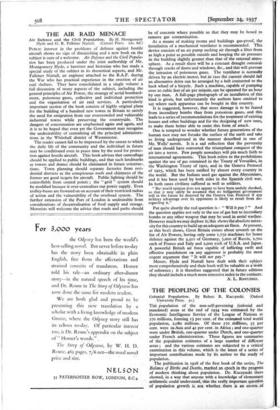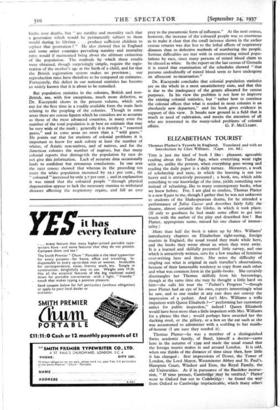THE PEOPLING OF THE COLONIES
Colonial Population. By Robert R. Kuczynski. (Oxford University Press. 5s.) THE population of the non-self-governing (colonial and mandated) areas at the end of 1934 was estimated by the Economic Intelligence Service of the League of Nations at 27o millions, forming 53 per cent. of the estimated total world population, 2,080 millions. Of these 270 _millions, 55 per cent. were imAsia and 42 per cent. in Africa ; and one-quarter were under British, one-quarter under Dutch, and one-quarter under French administration. These figures are summaries of the population estimates of a large number of diffuent areas ; and the various estimates are subjected to a critical examination in this volume, which is the latest of a series of important contributions made by its author to the study of population.
The publication in 5928 of the first book of the series, The Balance of Births and Deaths, marked an epoch in the progress of modem thinking about population. Dr. Kuczynski there showed, in a way that anyone with a knowledge of elementary arithmetic could understand, that the really important question of population growth is not whether there is an excess_ of
births over deaths, but " are natality and mortality such that a generation which would be permanently subject to them would during its lifetime . . . produce sufficient children to replace that generation ? " He also showed that in England and some other countries prevailing -natality and mortality rates would if maintained bring about the ultimate extinction of the population. The methods by which these results were obtained, though surprisingly simple, require the regis- tration of the mother's age at the birth of a child, and for that the British registration system makes no provision ; our reproduction rates have therefore to be computed on estimates. Fortunately, this defect in our national statistics has become so widely known that it is about to be remedied.
But population statistics in the colonies, British and non- British, are, with few exceptions, much more defective, as Dr. Kuczynski shows in the present volume, which sets out for the first time in a readily available form the main facts relating to the peopling of the colonies. Though in some areas there are census figures which he considers are as accurate as those of the most advanced countries, in many even the number of the total population is at best an estimate that may be very wide of the mark ; generally it is merely a " reasoned guess," and in some areas no more than a " wild guess." He points out that for students of colonial problems it is important to know for each colony at least the number of whites, of Asiatic non-natives, and of natives, and for the American colonies the number of negroes, but that many colonial reports that distinguish the population by race do not give this information. Lack of accurate data occasionally leads to confident but erroneous conclusions. In one area the 1921 census showed that whereas in the preceding ten years the white population increased by 19.1 per cent., the coloured " increased by only 3.7 per cent. ; and in explanation it was stated that the coloured people " through physical degeneration appear to lack the necessary stamina to withstand diseases affecting the respiratory organs, and fall an easy prey to the pneumonic form of influenza." At the next census, however, the increase of the coloured people was so enormous as to make it clear that the small increase shown in the earlier census returns was due less to the lethal effects of respiratory diseases than to defective methods of numbering the people. Serious difficulties are met with in enumerating mixed popu- lations by race, since many persons of mixed blood claim to be classed as white. In the report on the last census of Grenada it is stated that examination of the schedules showed " that persons undoubtedly of mixed blood seem to have undergone an albescent re-incarnation."
Dr. Kuczynski concludes that colonial population statistics are on the whole in a most unsatisfactory state, and that this is due to the inadequacy of the grants allocated for census purposes. In his view the problem is not how to improve the existing colonial statistics, but " rather how to convince the colonial offices that what is needed in most colonies is an absolutely new departure," and his book gives evidence in support of this view. It breaks new ground in a field that is much in need of cultivation, and merits the attention of all who are interested in the many-sided problems of colonial



















































 Previous page
Previous page